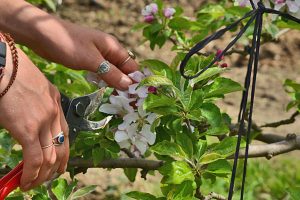 We’ve posted several times about thinning out just set fruit on fruit trees. As fruit tree blossoms are pollenized and the fruit begins to grow, it gives off ethylene gas. If enough of this gas is released, either because thinning happened late or not at all, many fruit trees will not develop as many fruit buds for next year. This tendency of a light (or non-existent) crop following a heavy crop is called biennial bearing.
We’ve posted several times about thinning out just set fruit on fruit trees. As fruit tree blossoms are pollenized and the fruit begins to grow, it gives off ethylene gas. If enough of this gas is released, either because thinning happened late or not at all, many fruit trees will not develop as many fruit buds for next year. This tendency of a light (or non-existent) crop following a heavy crop is called biennial bearing.
Some varieties are more prone to this biennial bearing than others. Most bitter cider apple varieties are strongly biennial, and some popular dessert apple varieties also have this tendency. Honeycrisp and Gravenstein are in this category. Even when you thin early, if you end up with a heavy crop, you may not have much fruit next year. The last couple of years, we’ve been experimenting with flower thinning these varieties and are finding this a very effective way to short circuit the biennial tendency.
Plums, cherries and pears can also show a tendency to biennial bearing. Flower thinning can be effective here as well, especially with plums and cherries that are more difficult to hand thin once the fruit is set.

